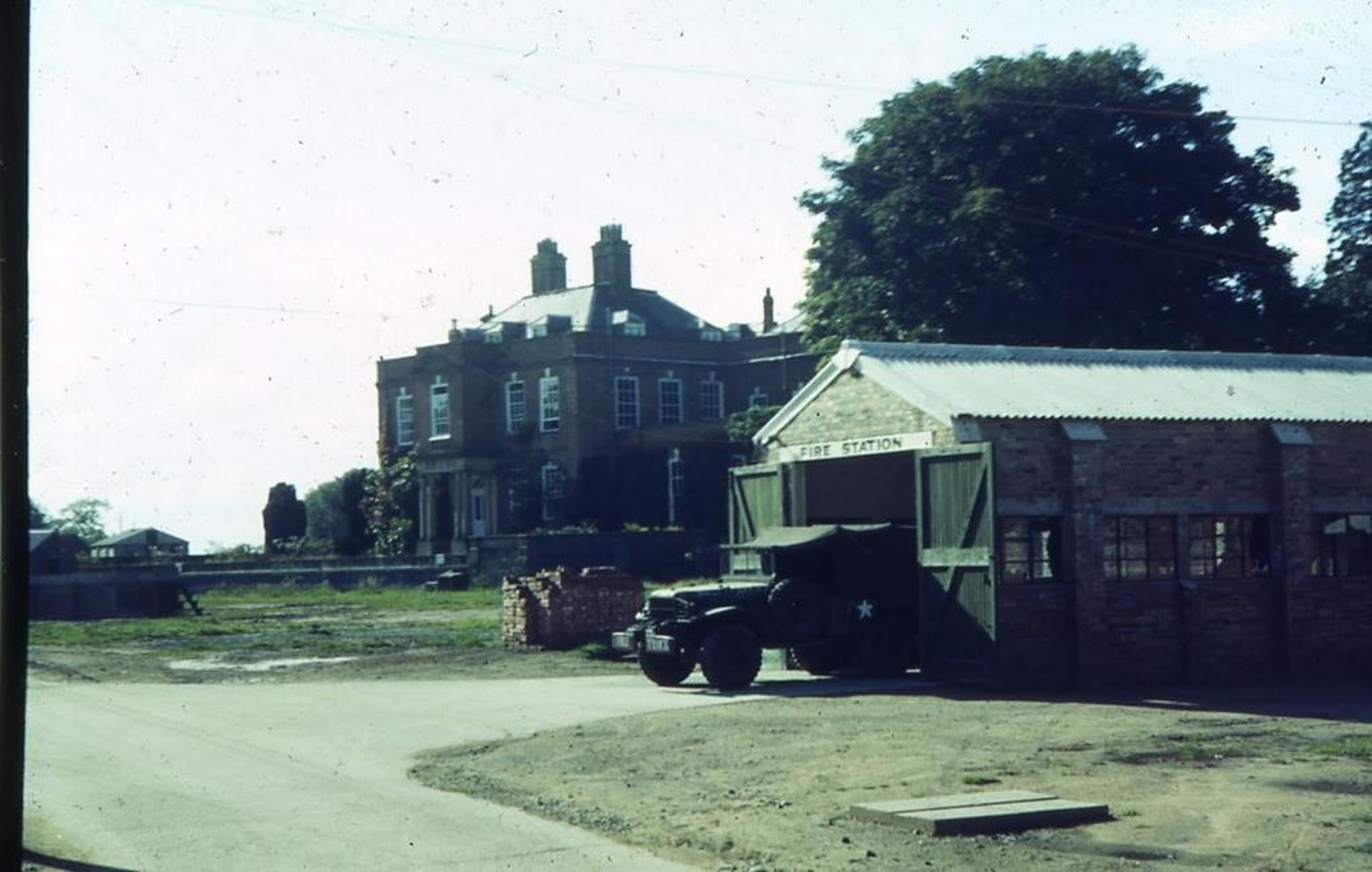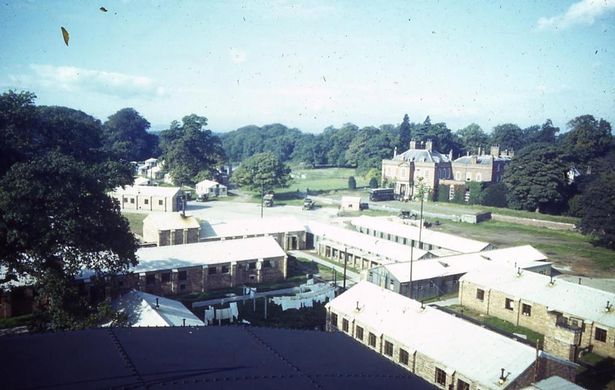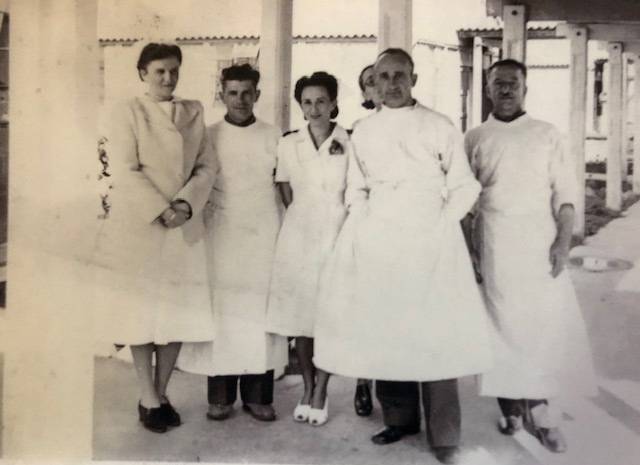Irena Jesman
A Truly Inspiring Survivor
Those of you who are familiar with Iscoyd’s history before it reincarnated as a beautiful wedding venue will already be aware that during the Second World War the house and gardens played a part in the war effort. The park at Iscoyd was requisitioned for use as a 1,500-bed hospital for the United States Forces with a prisoner-of-war camp in the enclosure. As Hugh Montgomery-Massingberd wrote: “The beautiful parkland was obliterated by an Orwellian nightmare of Nissen huts, barbed wire and control towers.” Immediately after the war it become a camp and hospital for Polish refugees and it was not until 1957 that the park was given back to the family. The photos below go some way in illustrating just how different the park and gardens looked back then in comparison to the manicured landscaping today.



Last month owner Philip had the honour of showing Andrew Jesman (Irena’s son) and his partner Juliet around the house and gardens. Irena, a remarkable woman last saw Iscoyd in 1947 after having worked as a nurse in the park since 1945 under Lieutenant Colonel Stan Orlowski.
Irena was a truly inspirational woman, an incredible survivor and we were blown away by her story and the distressing situations she endured before coming to the UK. Irena was expelled from her home, in Horochow in Eastern Poland (now Ukraine) when the Bolsheviks invaded Poland, along with her parents and her brother. She was just 18 years old.
Attempts to flee to Warsaw with her family were beset with betrayals and led to the family being imprisoned and interrogated and being accused of being German spies. The prison conditions were unbearable, overcrowding was common and the family were split up with Irena and her mother being separated from her brother and father. After some time in prison, Irena was ordered to go to Russia and finally arrived at the prison camp at Starobielsk. This was the last place Irena saw her father by chance walking in a group of other prisoners to the well, for water. She said he was changed beyond recognition and that as a former Judge who she said ‘had never signed a death sentence on any criminal and was opposed to the death penalty, always stating that one human had no right to take another’s life.’ He later died of pneumonia at the age of 58.
In Starobielsk, in a small room, Irena and her mother’s sentences were read out to them – five years compulsory labour in the Gulags where they remained until the end of September 1941, right up until “Stalin’s so-called amnesty”. Life was hard and Irena was forced to work as an outside labourer fighting bitterly cold conditions and wild wolves determined to eat them.


Irena is on the far left of the top photograph, and in the centre of the one with her medical colleagues. You would never guess from the beautiful portrait of her that she had been through such a dreadful time at the hands of the Russians just 3 years before the photo was taken in 1945.
When Stalin called his amnesty, Irena and her mother were told they were free to go. By chance they found out that the Polish army was being formed in a place called Buzułuk so under the cover of darkness, Irena along with her mother and some others finally reached Buzułuk. It was very late and dark and the gates to the Polish army camp were shut. By chance the Komendant said to the guard on duty “Let them in for the night and then tomorrow they’ll have to clear off.”
The following morning, serendipitously Elena met a gentleman called Mr Szufer who was working there in the camp. She said “it was like a miracle! He was my father’s old friend” and it was he who arranged for Irena to join the army as a nurse and her mother as a seamstress. After training in Wrewskoje with another girl who would later become her brother’s wife, Irena started her nursing career moving from camp to camp all over Europe.
In September 1943 her moving hospital, still under Major Jan Gujet, was transferred to Egypt and then in June 1944 her hospital was evacuated to England by ship to Glasgow and then by train to Ormskirk, arriving on July 7th. In 1945 the hospital was moved once again, this time to Iscoyd Park, Whitchurch, Shropshire, under Lieutenant Colonel Stan Orlowski, where Irena worked until 1947, when it was converted to a psychiatric hospital.

We were fortunate to be shared a couple of her experiences from her time at Iscoyd with us which we simply felt we must share with you…
“One morning I was up earlier than my colleagues and because it felt so cold I went to the stove and saw that it was not properly alight. I opened the door and poked it with the poker – the stove exploded, badly burning half my face. It was just before New Year’s Eve – spoiling my plans for the evening, I was looking forward to! Because of the nature of my burns, the doctors were concerned about infection and potential scarring and they decided to try using penicillin powder (only newly available for military use), applying a thick layer to my face over the area of the burns. I remained in hospital for six weeks and eventually the crust was peeled away to reveal new, very sensitive skin, but miraculously unscarred.”
And…
“On another occasion, not long after this, I went cycling on a bike, which I had bought for myself with the help of a young Polish male friend. I was accompanied by the son of one of my nursing friends, a boy of about sixteen years old. However, I was very out of practice and I was going down the hill too fast and eventually crashed, this time badly grazing my knees. We were near a farm and the young lad went running off, coming back with a bucket full of water to splash on my legs – unfortunately it was not water but diesel fuel! When I got back to the hospital the Matron said that at least it was probably was a good disinfectant and told the others, “This girl is not destined to die of natural causes!”
We think you will agree that Irena’s journey is that of a survivor. She says in her memoir “Fate forced me to undertake my unplanned journey, not sparing me degradation, humiliation and hunger, to end up years later as an immigrant on foreign soil, trying to start to live again”
Thank you for coming to visit us Andrew and thank you so much for sharing your mothers stories here at Iscoyd which we were honoured to listen to. Irena is a part of Iscoyd’s history and her experiences, as well as so many others who have played a role here in the house and gardens, are important to record, remember and share with our community.
You are truly an inspiration to us all.
All our Iscoyd love
xxx
ROCK MY WEDDING
"Iscoyd Park offers as much gorgeousness on the inside as it does on the outside. It really is one of the best wedding venues in the UK."
Privacy Policy
|
Photography Credits
Site design by Spirit Level
|
Site created by Paper Green Creative
Copyright Iscoyd Park LLP 2025. All rights reserved
Join our exclusive email list for all the latest Iscoyd happenings
join the iscoyd list
links
Office Opening Hours:
Mon - Fri 9:30am - 5:30pm
+44 (0)1948 780785
Iscoyd Park
Whitchurch
Shropshire
SY13 3AT
find us
Iscoyd Park has been in the Godsal family since 1843, Phil and Susie Godsal took over the running of the house in 2009 and began a much needed restoration project. They live in the house today with their three children and run it both as a wedding and events venue and a family home. Find out more about us.
about
subscribe
love our house?
Explore hundreds of beautiful and historic houses like Iscoyd Park. Click here to become a member of Historic Houses.
Enter the code ISC085 to qualify for a discounted price.